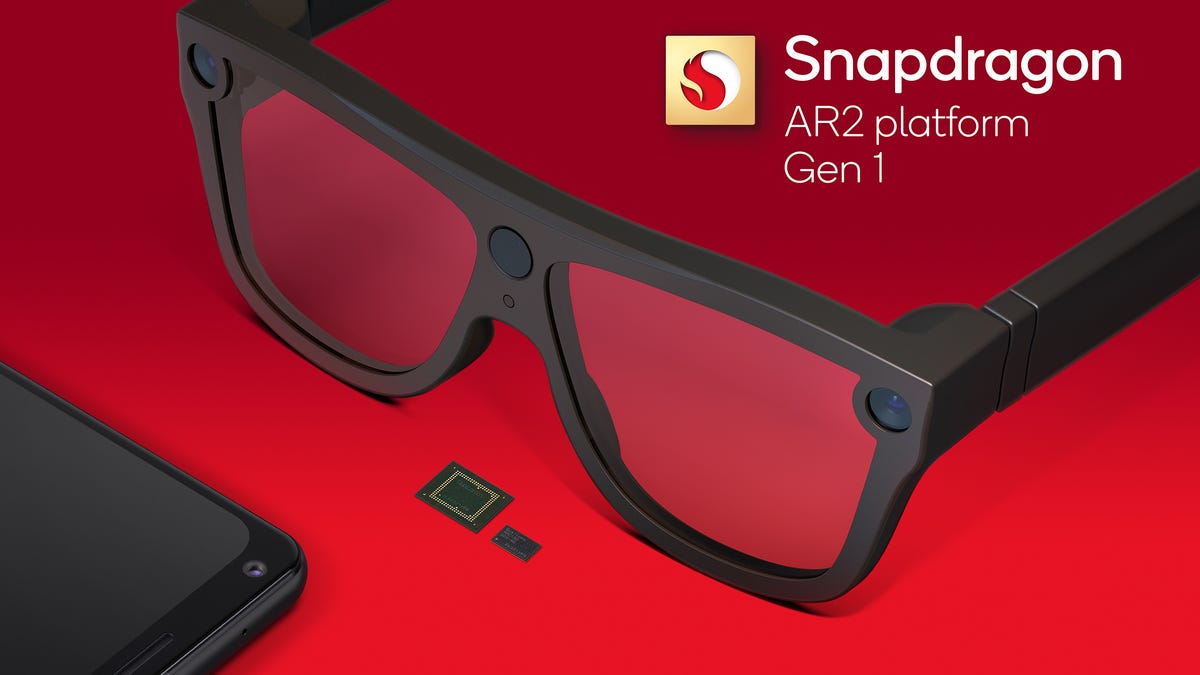Technologies
Qualcomm’s New AR Chips Point to a New Generation of Smart Glasses
The less power-hungry chips support Wi-Fi 7 and eye tracking. They’re expected to arrive in glasses between 2023 and 2025.

Amid a recent uptick in VR headsets, Qualcomm’s latest chip announcement hints that the next product wave could be AR glasses. At the company’s recent chip-focused event, the newest Snapdragon phone processors were announced, along with a brand-new line of AR glasses-optimized chips that point to a next wave of advanced smartglasses expected to arrive between 2023 and 2025, with possible features including eye tracking, hand tracking and wireless streaming to phones or from the cloud.
The Snapdragon AR2 Gen 1 is a different type of platform than the company’s top-end XR2 processor, which is already in standalone VR headsets like the Meta Quest 2 and Pico 4. The AR2 focuses more on camera and sensor-based processing than on graphics, aiming to improve battery life on smaller glasses. The design is split into three co-processors, which are meant to live in each arm of a pair of smartglasses and also above the bridge. It’s meant to cut down on wires and reduce overheating on future glasses designs.
Glasses using the AR2 Gen 1 may be a lot faster at using cameras for scanning and depth sensing: Qualcomm is promising faster AI for things like object recognition and hand tracking than even the XR2 chip found on headsets such as the Quest 2, but using half as much power as the XR2 chip. There’s nowhere to hide a big battery on a normal-ish pair of glasses, which is why the AR2 Gen 1 aims to be efficient in ways that are reminiscent of the needs of wearables like smartwatches.
The AR2 Gen 1 chip won’t be used for traditional VR headsets. According to Qualcomm, the resolution and field of view in AR glasses using these new chips won’t be as good as what current VR is capable of. Existing AR glasses and headsets tend to have smaller viewing areas and rely on occasional pop-up graphics, versus the expansive full-field graphics and displays VR needs.
Qualcomm is leaning heavily on phones, computers and the cloud to do a lot of the heavy lifting for these future glasses. The chipset includes Wi-Fi 7, and a range of phones running Qualcomm’s Snapdragon chips and the Snapdragon Spaces software platform could be used to wirelessly process AR graphics for these glasses. Essentially they’re wearable peripherals, although the glasses could do some things on their own, too.
Eye tracking on the glasses comes with support for iris authentication, which is handled on-glasses with a dedicated security chip. How that gets used by other manufacturers, however, remains to be seen.
Qualcomm’s already announced a wave of familiar tech names that are onboard to make AR glasses with the AR2 chip, including Lenovo, LG, Niantic, NReal, Oppo, Pico, NTT Qonoq, Rokid, Sharp, TCL, Vuzix and Mi. Microsoft and Adobe are also working on making their software platforms cross-compatible, which mirrors recent partnership news with Meta earlier this year.
Partnerships are necessary, especially for devices like smart glasses that are trying to be useful tools in a world of already well-connected phones, computers, wearables and smart home gear. Microsoft has already announced a partnership with Qualcomm on future AR glasses chips earlier this year, and the AR2 Gen 1 looks like it’ll be a part of that evolution beyond the expensive, business-focused HoloLens 2.
Qualcomm previously worked on chips for existing AR headsets and smart glasses, including the NReal Light, Lenovo’s ThinkReality A3 and Meta’s Ray-Ban Stories. However, Qualcomm’s head of XR, Hugo Swart, indicated in a briefing with reporters that current efforts haven’t been good enough at running long enough on a single battery charge to be useful. (Battery life on nearly all existing VR and AR headsets tends to be under 2 hours at best.)
Dreams of the metaverse are, for the moment, held back equally by hardware and software. While VR headsets are slowly adding AR-like features using passthrough cameras, like in the Meta Quest Pro, there aren’t any all-day AR glasses that are actually any good, although some headsets like the Magic Leap 2 are trying to get closer to being useful for practical business uses. Perhaps Meta, which has been promising its own AR glasses for years, will lean on the AR2 Gen 1 as well for a future product.
There’s nothing available yet that resembles the eyeglass tech sci-fi writers have been dreaming of for decades. Qualcomm’s new chips may not lead to perfect AR glasses, but these chips may lead to improved, wireless glasses of the type that haven’t existed previously. Maybe this wave of AR2 Gen 1-enabled glasses could be the start of the true AR eyewear we’ve been waiting for.
Technologies
Quadrantids Is a Short but Sweet Meteor Shower Just After New Year’s. How to See It
This meteor shower has one of the most active peaks, but it doesn’t last for very long.

The Quadrantids has the potential to be one of the most active meteor showers of the year, and skygazers won’t have long to wait to see it. The annual shower is predicted to reach maximum intensity on Jan. 3. And with a display that can rival Perseids, Quadrantids could be worth braving the cold to see it.
Don’t miss any of our unbiased tech content and lab-based reviews. Add CNET as a preferred Google source.
The show officially begins on Dec. 28 and lasts until Jan. 12, according to the American Meteor Society. Quadrantids is scheduled to peak on Jan. 2-3, when it may produce upwards of 125 meteors per hour. This matches Perseids and other larger meteor showers on a per-hour rate, but Quadrantids also has one of the shortest peaks at just 6 hours, so it rarely produces as many meteors overall as the other big ones.
The meteor shower comes to Earth courtesy of the 2003 EH1 asteroid, which is notable because most meteor showers are fed from comets, not asteroids. Per NASA, 2003 EH1 is a near-Earth asteroid that orbits the sun once every five and a half years. Science posits that 2003 EH1 was a comet in a past life, but too many trips around the sun stripped it of its ice, leaving only its rocky core. The Earth runs through EH1’s orbital debris every January, which results in the Quadrantids meteor shower.
How and where to see Quadrantids
Quadrantids is named for the constellation where its meteors appear to originate, a point known as the radiant. This presents another oddity, as the shower originates from the constellation Quadrans Muralis. This constellation ceased to be recognized as an official constellation in the 1920s and isn’t available on most publicly accessible sky maps.
For the modern skygazer, you’ll instead need to find the Bootes and Draco constellations, both of which contain stars that were once a part of the Quadrans Muralis. Draco will be easier to find after sunset on the evening of Jan. 2, and will be just above the horizon in the northern sky. Bootes orbits around Draco, but will remain under the horizon until just after 1 a.m. local time in the northeastern sky. From that point forward, both will sit in the northeastern part of the sky until sunrise. You’ll want to point your chair in that direction and stay there to see meteors.
As the American Meteor Society notes, Quadrantids has a short but active peak, lasting around 6 hours. The peak is expected to start around 4 p.m. ET and last well into the evening. NASA predicts the meteor shower to start one day later on Jan. 3-4, so if you don’t see any on the evening of Jan. 2, try again on Jan. 3.
To get the best results, the standard space viewing tips apply. You’ll want to get as far away from the city and suburbs as possible to reduce light pollution. Since it’ll be so cold outside, dress warmly and abstain from alcoholic beverages, as they can affect your body temperature. You won’t need any binoculars or telescopes, and the reduced field of view may actually impact your ability to see meteors.
The bad news is that either way, the Quadrantids meteor shower coincides almost perfectly with January’s Wolf Moon, which also happens to be a supermoon. This will introduce quite a lot of light pollution, which will likely drown out all but the brightest meteors. So, while it may have a peak of over 100 meteors per hour, both NASA and the AMS agree that the more realistic expectation is 10 or so bright meteors per hour.
Technologies
Today’s Wordle Hints, Answer and Help for Dec. 24, #1649
Here are hints and the answer for today’s Wordle for Dec. 24, No. 1,649.

Looking for the most recent Wordle answer? Click here for today’s Wordle hints, as well as our daily answers and hints for The New York Times Mini Crossword, Connections, Connections: Sports Edition and Strands puzzles.
Today’s Wordle puzzle is a little tricky, with a double letter that could confuse players. If you need a new starter word, check out our list of which letters show up the most in English words. If you need hints and the answer, read on.
Read more: New Study Reveals Wordle’s Top 10 Toughest Words of 2025
Today’s Wordle hints
Before we show you today’s Wordle answer, we’ll give you some hints. If you don’t want a spoiler, look away now.
Wordle hint No. 1: Repeats
Today’s Wordle answer has one repeated letter.
Wordle hint No. 2: Vowels
Today’s Wordle answer has one vowel, but it’s the repeated letter, so you’ll see it twice.
Wordle hint No. 3: First letter
Today’s Wordle answer begins with S.
Wordle hint No. 4: Last letter
Today’s Wordle answer ends with L.
Wordle hint No. 5: Meaning
Today’s Wordle answer can refer to a cylindrical device upon which thread is wound.
TODAY’S WORDLE ANSWER
Today’s Wordle answer is SPOOL.
Yesterday’s Wordle answer
Yesterday’s Wordle answer, Dec. 23, No. 1648 was GLINT.
Recent Wordle answers
Dec. 19, No. 1644: MYRRH
Dec. 20, No. 1645: WHITE
Dec. 21, No. 1646: QUILT
Dec. 22, No. 1647: CONCH
Don’t miss any of our unbiased tech content and lab-based reviews. Add CNET as a preferred Google source.
Technologies
Today’s NYT Connections: Sports Edition Hints and Answers for Dec. 24, #457
Here are hints and the answers for the NYT Connections: Sports Edition puzzle for Dec. 24, No. 457.

Looking for the most recent regular Connections answers? Click here for today’s Connections hints, as well as our daily answers and hints for The New York Times Mini Crossword, Wordle and Strands puzzles.
Today’s Connections: Sports Edition is a bit of a toughie, with a lot of proper nouns included. If you’re struggling but still want to solve it, read on for hints and the answers.
Connections: Sports Edition is published by The Athletic, the subscription-based sports journalism site owned by The Times. It doesn’t appear in the NYT Games app, but it does in The Athletic’s own app. Or you can play it for free online.
Read more: NYT Connections: Sports Edition Puzzle Comes Out of Beta
Hints for today’s Connections: Sports Edition groups
Here are four hints for the groupings in today’s Connections: Sports Edition puzzle, ranked from the easiest yellow group to the tough (and sometimes bizarre) purple group.
Yellow group hint: What separates two entities.
Green group hint: Head to the mountains.
Blue group hint: Mitt makers.
Purple group hint: Kick it.
Answers for today’s Connections: Sports Edition groups
Yellow group: Gap between two opponents.
Green group: A skier’s needs.
Blue group: Baseball glove manufacturers.
Purple group: NFL punters.
Read more: Wordle Cheat Sheet: Here Are the Most Popular Letters Used in English Words
What are today’s Connections: Sports Edition answers?
The yellow words in today’s Connections
The theme is gap between two opponents. The four answers are advantage, edge, lead and margin.
The green words in today’s Connections
The theme is a skier’s needs. The four answers are boots, poles, skis and snow.
The blue words in today’s Connections
The theme is baseball glove manufacturers. The four answers are Mizuno, Nike, Rawlings and Wilson.
The purple words in today’s Connections
The theme is NFL punters. The four answers are Anger, Haack, Stout and Way.
Don’t miss any of our unbiased tech content and lab-based reviews. Add CNET as a preferred Google source.
-

 Technologies3 года ago
Technologies3 года agoTech Companies Need to Be Held Accountable for Security, Experts Say
-

 Technologies3 года ago
Technologies3 года agoBest Handheld Game Console in 2023
-

 Technologies3 года ago
Technologies3 года agoTighten Up Your VR Game With the Best Head Straps for Quest 2
-

 Technologies4 года ago
Technologies4 года agoBlack Friday 2021: The best deals on TVs, headphones, kitchenware, and more
-

 Technologies4 года ago
Technologies4 года agoVerum, Wickr and Threema: next generation secured messengers
-

 Technologies4 года ago
Technologies4 года agoGoogle to require vaccinations as Silicon Valley rethinks return-to-office policies
-

 Technologies4 года ago
Technologies4 года agoOlivia Harlan Dekker for Verum Messenger
-

 Technologies4 года ago
Technologies4 года agoiPhone 13 event: How to watch Apple’s big announcement tomorrow
